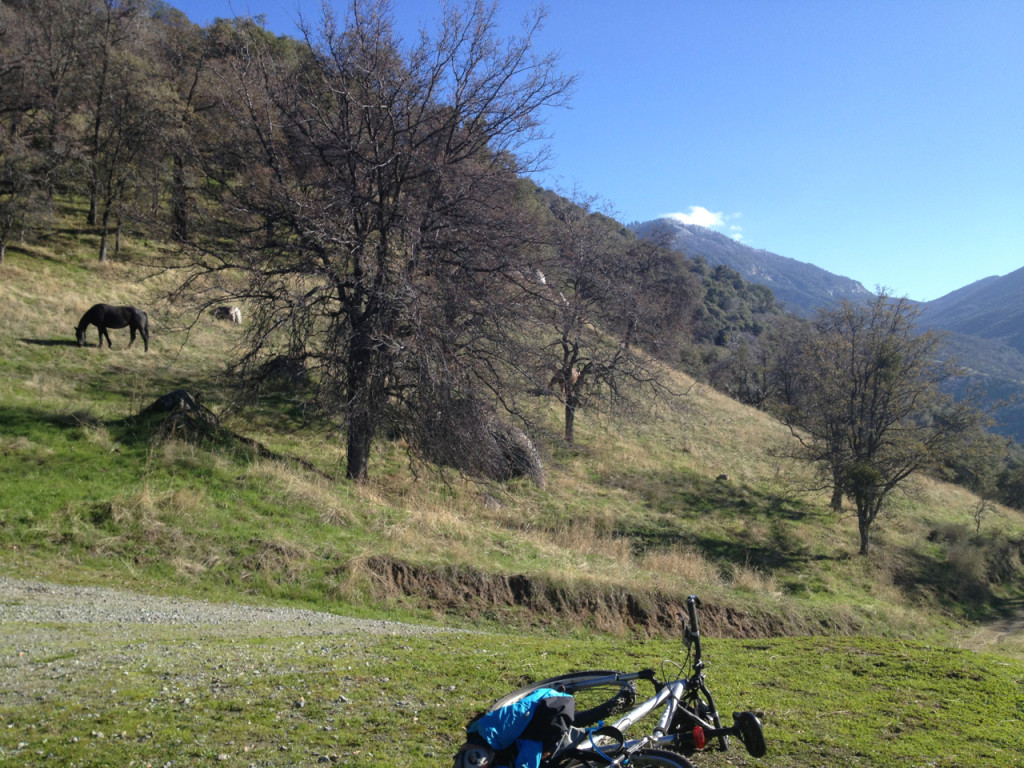
THE PEDESTRIAN’S GUIDE TO WRITING HORSES
4: Practicality
Let me make one thing clear: Horses are NOT bicycles. As you may have learned from the previous chapters, horses are large, unpredictable, and opinionated. They are also surprisingly injury-prone (see Chapter 6: Illness and Injury). All this makes them (by modern standards) an unreliable mode of transportation even when they are decently trained and have a good rider. But the best trained horse under the best rider will not be able to avoid bad luck such as stones lodged in hooves, strained muscles, or surprise bouts of colic. So while it would be annoying and likely detrimental to the story to have horses constantly going lame/sick (which they do not), it is a good idea not to assume they will perform like modern automobiles. Instead, salt your story with riders being late because their horse picked up a stone (much more common than throwing a shoe, though this is also not unusual) and went lame. Allow your horses to take fright at things, to balk at crossing water (most horses can be trained to cross water with little or no fuss; key word: most), and to pause mid-stride to take a bite out of the shrubbery, bit or no bit. Even if you don’t intend to develop your equines into fully fledged characters, scattering some of these quirks into your herd of horse-bicycles will help sustain the illusion that they are, in fact, animals, and not just the sword and sorcery fantasy version of a moped.
To help, here is a rundown of what can realistically be expected of horses when used for transportation.
On a flat, well-paved road, a horse walks at about the same speed as a human. They can, however, carry a lot more weight. So if your character is transporting some bulky Quest Objects, allow them a horse but don’t expect them to go much faster than if they were walking themselves.
To get a horse to go faster than a human walk they’ll need to be trotting: either a slow, relaxed trot that can be sat with little effort and that the horse can keep up all day (commonly called a jog or a Western Trot, as the cowboys preferred it for crossing long distances); or a brisk trot that the rider must post or be shook to pieces. Posting is when the rider raises and lowers their seat in time with one of the horse’s forelegs (when in an arena, it is proper to rise as the outer foreleg is moving forward). It is a lot more work than merely sitting a trot, but it’s much more comfortable if the horse is trotting fast enough. Posting is easiest when you have a pair of good stirrups to support your feet, but can be done without them. Indeed it can be done bareback, but that is much harder.
A horse at an extended trot is about equal to a fast human runner—but again they can carry more weight, and the average horse can keep the speed up longer than the average human.
These two gaits (the walk and varying speeds of trot) are what most riders will use to get about on. Only rarely will they canter or gallop, as horses can get hard to control at those speeds, and everyone gets tired more easily. However, when horses get into a gallop they can cover a lot of ground. So if you’ve got an express messenger needing to get from A to B in a hurry that’s what they’ll use. If A and B are too far apart for one horse to gallop the whole way, the rider may rely on stages—switching their mount for fresh ones at prearranged points.
This is all for horses on reasonably flat, well-maintained roads. Off-road is a whole other story.
On horseback the rougher the trail the faster they will go in relation to humans—even at a walk. Uneven ground, high grass, steep rises—these pose no great impediment to a horse. They will happily stomp right through low bushes and trees (sometimes scraping off unwary riders in the process), that would severely hinder a person. A nimble horse can even navigate rocky river bottoms with little difficulty.
Generally, however, the rougher the trail the slower the horse goes: so although it’s very well to want your hero to gallop through the river, sending streams of frothing water to either side, this is highly unadvisable unless you know the depth and power of the water, and can assume the bottom is even and firm. Things that, in my experience, river bottoms tend not to be.
Similarly, you’re not going to gallop all-out along a narrow, winding mountain trail—unless the forces of the Dark Lord are right there in hot pursuit, in which case one could argue necessity is the mother of improbable feats.
Keep in mind that the faster you ride and the rougher the trail, the more likely your character and their horse are to sustain an injury. As mentioned before, the horse may pick up a stone, twist its leg, or in extreme cases suffer a stress fracture. A rider is more likely to have bits knocked off by passing scenery, or get thrown from their mount completely—an action that can understandably result in everything from bruises to sudden death.
Horses can traverse a variety of terrain. Though they’ll want shoes for going on cobbled or stone-paved roads (or asphalt or concrete, while we’re at it). A barefoot horse can have good grip on rock, but will go tender-foot unless they have exceptionally hard hooves. A horse with metal shoes will be more comfortable, but is more likely to slip. Metal shoes are also a no-go in snow, as the snow will freeze to the metal and create balls of ice than can damage the horse’s hoof.
Horses do NOT like mud. Nothing will spook a horse like feeling its feet getting sucked into the ground. Conversely, horses tend to like sand. Whether it is the hard-packed sand you find under the breakers at the beach or the soft sand of the dunes. Horses like soft sand so much, they may stop and try to roll in it even with someone on their back.
Horses are variable when it comes to water. Some horses love water, and will enter it unasked. Others will sooner walk through fire. All horses can be trained to tolerate it further, though the less experienced the rider the harder it will be to get them to obey (this goes for everything). Most horses will, however, at least pause before crossing water, as they cannot always tell how deep it is and they will want to go slowly.
Rain will not disturb a horse one iota. It is much more likely to disturb their rider, whose thighs and shoulders will get very wet very fast unless they have a great coat on (cloaks do not work unless they are magical and/or elven).
A horse in good condition can go hard all day, have a good night’s rest, and be up for it again the next. Older horses (over twelve or thereabouts) will tire sooner and sooner the older they are; the same goes for horses who have not been kept in exercise—though any healthy horse off of pasture can be good for a reasonable day’s work. But the harder a horse is worked the more care they will need afterwards.
You cannot just throw the horse into the stables—unless there are some obliging grooms to take care of it. If a horse has been ridden hard (galloped for more than a few minutes) it should be cooled down by either walking or very slow trotting for at least fifteen minutes. If it has worked up a sweat and it is a cool day, it should be walked until the sweat has dried (this is to prevent it getting a chill). Wet, sweaty horses should not be blanketed, as the blanket will keep them wet. Walk until dry, then blanket. If raining, put in stall and give lots of hay. Digesting food creates body heat, and will keep the horse from over-cooling.
If wet, sweaty, and it’s cold out, do not give large amounts of cold water. This can super-cool their insides and bring on hypothermia (goes for humans as well). If horse is thirsty, walk and give small amounts of cool water at intervals of about 10 minutes. If warm water is available, however, let them drink as much as they want of that. It is a matter of temperature, not hydration. In hot weather all this is moot: horses should be allowed to drink as much as they want whenever they want when it is warm (except when they are seriously dehydrated; see Chapter 5: Care and Maintenance).
Also, after riding one must brush down the horse—this can aid in sweat drying, but it also settles the hair that may have been disrupted by the tack—and check their feet for stones (this should be done before riding as well; brushing and hoof-picking, as well as saddling and bridling, are generally covered under “Perkins, go saddle Thunderbolt for me, will you?”).
After the horse has been cooled, watered and groomed then it can be put away to feed and the characters may get on about their business. You needn’t cover this process in detail, but it can take anywhere from five to twenty minutes, so make allowances for that if there is no handy groom to take over.
All in all horses are somewhat cumbersome as transportation: they are moody and accident prone, they can take fright at the smallest of things, and they are, on the whole, not much faster than a human—unless galloping, which is difficult to ride for long periods of time. Yet you need not dwell on these shortcomings so long as you have your horses perform within reasonable capacity and make at least a couple references to the faults I have outlined here.
In the next chapter I will go over the day-to-day care and maintenance of these animals. While not likely to be important while your characters are out Saving the World, if they live in a pre-industrial society that uses horses as beasts of burden they will probably know these things—and so so should their author.
On to Chapter 5: Care and Maintenance ->
Goldeen Ogawa has been working with and around horses since she was five years old, has been a horse-owner since 2000, and currently rides every week. If you have any questions about horses not answered here you can email her at goldeenogawa@gmail.com or peck at her on Twitter @GrimbyTweets. There you can also follow her weekly horse pictures under the #TweetsFromHorseback hashtag.
























